BHUJ
Our journey starts here in the wonderful, historic city of Bhuj. As the capital of Kutch, Bhuj is the most convenient place to access the Rann of Kutch and all the nearby locations worth visiting. This is not to say that Bhuj in itself is not a treasure for the traveler. There is so much to see here that any person visiting the city will require at least two days absorbing its rich heritage and historic significance.
Bhuj gets its name after the Bhujiyo Dungar- a 160m hill that overlooks the city and is said to be the home of the great serpent Bhujang. The most popular place in the city of Bhuj is the Aaina Mahal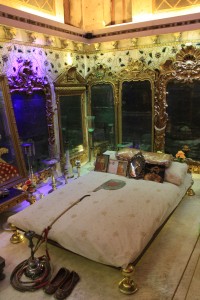 - a beautiful palace built in 1752. The name Aaina Mahal itself suggests that it is a Palace of Mirrors and how! The elaborately mirrored interior of the entire palace suggests the opulence and grandeur of the by-gone era. Maharao Lakhpatji- the person who built the palace was fascinated by all things flamboyant and extravagant and it is noticed the moment you enter the building. The architecture of the palace is heavily influenced by European style of décor. Right from the blue-and-white Delphi-style tiling and the Hogarth lithograph series to Belgium chandeliers and Rococo style intricately carved, gold plated mirror frames, it is a wonderful experience to walk through these rooms and soak in the grandeur.
- a beautiful palace built in 1752. The name Aaina Mahal itself suggests that it is a Palace of Mirrors and how! The elaborately mirrored interior of the entire palace suggests the opulence and grandeur of the by-gone era. Maharao Lakhpatji- the person who built the palace was fascinated by all things flamboyant and extravagant and it is noticed the moment you enter the building. The architecture of the palace is heavily influenced by European style of décor. Right from the blue-and-white Delphi-style tiling and the Hogarth lithograph series to Belgium chandeliers and Rococo style intricately carved, gold plated mirror frames, it is a wonderful experience to walk through these rooms and soak in the grandeur.
Right next to the Aaina Mahal is the Prag Mahal palace which was the residence of Maharao Lakhpatji. Built in the 18th century under the patronage of king Pragmal, this palace is a splendid work of art with Gothic style architecture. If you are game for it, do climb the stairs of the 42 feet high bell tower and get an exhilarating view of the entire city of Bhuj.
If you want to explore Bhuj in an even better way, it is best to take a stroll along the banks of the serene Hamirsar Lake at the centre of Bhuj. This provides a great opportunity to pass all the important monuments right from the Aina Mahal and Prag Mahal, the Kutch Museum, the Ramkund Stepwell and the Swaminarayan Temple which are all located alongside the lake.
After so much wandering about and walking, one is bound to be reminded by the good ol’ tummy to treat it well. And what’s better to do than to dig into the lip-smacking cuisine of Kutch? The ‘Kutchi Thali’ at hotel Prince or Hotel Annapurna at Bhuj will send you to Gujarati heaven right from the first morsel and even the pickiest eater will gorge on the food!
After the massive Gujarat earthquakes in 2001, there was a pressing need to rehabilitate Kutch’s rich, creative handicraft industry. However, since most artisans had lost their homes and means of livelihood, many NGO’s stepped up and established places where artisans could work and sell their handicrafts. Today, these places are inspiring hubs of creativity. Here you can meet weavers, tie-dye artists and block printers, potters and even leather workers amongst many others. You can share a cuppa sweet tea with the village artists while interacting with them and get to know about their culture, craft and way of life. Bhujodi, Shrujan, Khamir, Ashapura Crafts Park, etc are a few of the places totally worth a visit. 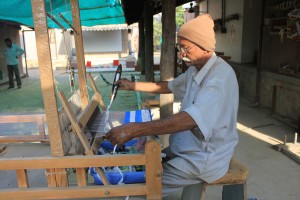 Khamir in particular is really interesting to visit as it sells a wide range of handicraft, local products made by Kutch artisans. The profits made from the sales go directly to the artisans and their promotion. You can buy an ever-trendy bandhani dress, woven camel wool shawl, delicate silver jewellery or even the intricately carved wooden artefacts amongst many other products and be assured of the authenticity of each single piece you buy.
Khamir in particular is really interesting to visit as it sells a wide range of handicraft, local products made by Kutch artisans. The profits made from the sales go directly to the artisans and their promotion. You can buy an ever-trendy bandhani dress, woven camel wool shawl, delicate silver jewellery or even the intricately carved wooden artefacts amongst many other products and be assured of the authenticity of each single piece you buy.
From Bhuj, we move along to the coastal city of Mandvi, south of Bhuj. Located on the banks of the river Rukmavati, Mandvi is best known for its pristine beach, the still-active shipbuilding yard and the mesmerizing Vijay Vilas Palace.  This palace was built in 1929 and is nestled in 450 acres of lush greenery. Still resplendent with its regal charm, it has now been converted into a resort and ensures that anyone who stays here is treated like royalty. Take a break from your routine life and enjoy a majestic sunset (and if you are an early-bird, the sunrise too) from one of the balconies in the palace while watching peacocks and an occasional Chinkara frolic the palace grounds. A night’s stay here will work wonders to rejuvenate and re-energize you!
This palace was built in 1929 and is nestled in 450 acres of lush greenery. Still resplendent with its regal charm, it has now been converted into a resort and ensures that anyone who stays here is treated like royalty. Take a break from your routine life and enjoy a majestic sunset (and if you are an early-bird, the sunrise too) from one of the balconies in the palace while watching peacocks and an occasional Chinkara frolic the palace grounds. A night’s stay here will work wonders to rejuvenate and re-energize you!
For the adventurous traveller who prefers to stay as close to mother nature as possible, the Mandvi Beach Resort is the perfect option. This resort combines the old world colonial charm with the modern day luxury facilities through the 10 Swiss Deluxe tents pitched on a white sand beach with blue waves lapping at its shores. The beach is open exclusively for the guests of the resort and one can bask in the glorious sun-kissed beach or soak in the crystal clear water of the Arabian Sea. The camp also has a restaurant made of a thatched roof and bamboo with a majestic view of the Arabian Sea and some finger licking good food (a given that sea-food is a speciality here). And if you are looking to woo and charm your significant other, you could not have come to a better place! The resort will arrange for a special romantic candle light barbeque right on the beach just for you.
From Mandvi, we head up north again to the Shaam-e-Sarhad Village Resort, owned and operated by the people from Hodka Village. This resort gives you a unique opportunity to be hosted by the local community, stay in well equipped mud huts furnished by the local arts and crafts and eat the local food in order to truly experience their culture. They even have a delightful performance of the local Kutchi folk dance for everyone to enjoy and take part in. This adds to the charm of the resort as people get to learn the local dance and interact with each other while enjoying the star-spangled night.
Close to the Hodka Village, is the popular mountain range of the Kalo Dungar or the Black Hills. The top of this range is the highest point in Kutch, at 462 m. And here one can witness the highlight of the trip- The Great Rann of Kutch! As the name suggests the Great Rann of Kutch, reputed as the largest salt desert in the world, spans an area of 7505.22 Sq. km. It is an awe-inspiring sight to see the stark white Rann uniting with the horizon at infinity, making you feel like you are truly standing at the edge of the earth. Since it is too sunny during the day, it is best to come here before sunset to truly enjoy the experience of watching the white Rann turn golden and then orange as the Sun’s setting rays kiss the land to bid it a good night. This is one of the places where civilians can get closest to the Pakistan border and even drive up to the India Bridge which is the last point where civilians can reach in this part of India.
Since the entire Kutch province is relatively a dry and arid landscape, water is a precious resource. One can find a very unique technique for rain water harvesting in this part of India. The Dhordo village near Hodka has an ancient water harvesting technique called Virda that everyone must see and learn from. The locals dig shallow wells in low depressions called jheels (tanks) which accumulate and store rain water in such a way that it filters the salty hard water from the potable fresh water. These Virdas are found all over the Banni grasslands, a part of the Great Rann of Kutch.
After this inspection of the brilliant engineering our ancestors have developed, it is time to catch up on some of the gastronomic pleasures that are on offer in this part of the world. The Bhirandiyari Village is where one should head to eat the famous kutchi Mavo- a delicious sweet made from milk and some sweet and strong tea. As the Rann of Kutch is a sensitive area due to its proximity to the Pakistani border, a special tourist permit needs to be obtained at the Bhirandiyari village in order to visit the Great Rann of Kutch.
Today, everyone is aware of the grand Rann Utsav that takes place each year right here at a village called Dhordo on the Banni Grasslands. Started in 2005 by the Tourism Corporation of Gujarat Limited (TCGL) as a three day affair, the Rann Utsav has grown into a huge affair of three months today. Celebrated each year during December to March, the festival provides an exclusive opportunity to witness the creative initiative of the artisans and craftspeople of Gujarat. Cultural troupes from various districts of Gujarat participate in the Dance and Musical Carnival. The highlight of the event though, is the full moon shining upon the white sands of the Rann and casting a silvery sparkle across its vast expanse. In the evenings, it is a picture perfect sight to see the sunset over the far off flat salt laden Rann and the multihued turbans and lehengas of the local men and women all around you.
After a humbling day of witnessing so many enthralling sights, we head back to the Sham-e-Sarhad resort for a hearty meal and a good night’s sleep. The next day, we move on to the Nirona village via Hodka. 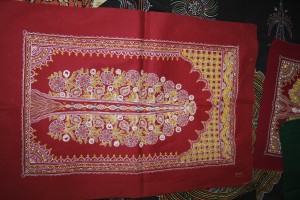 Nirona Village is a special place as it is home to the 300 year old art of Rogan painting. This is a free hand painting style and done without using any prior sketched pattern on the fabric. The painter uses a 6 inch long, thin metal stylus, dipped into the colour and carefully turned to wrap the Rogan around it to paint the fabric. Today, the Rogan art exists only in this part of the world and Khatri Ghafoor Bhai along with his family has kept the art alive by practicing it for generations. Along with the Rogan art, Nirona is also famous for two other rare arts, namely,
Nirona Village is a special place as it is home to the 300 year old art of Rogan painting. This is a free hand painting style and done without using any prior sketched pattern on the fabric. The painter uses a 6 inch long, thin metal stylus, dipped into the colour and carefully turned to wrap the Rogan around it to paint the fabric. Today, the Rogan art exists only in this part of the world and Khatri Ghafoor Bhai along with his family has kept the art alive by practicing it for generations. Along with the Rogan art, Nirona is also famous for two other rare arts, namely, 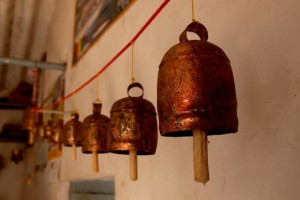 Copper Bell Making and Lacquer work. Only two villages in India make the Copper bells – Nirona and Zura. It is done by the Lohars of the Muslim community.
Copper Bell Making and Lacquer work. Only two villages in India make the Copper bells – Nirona and Zura. It is done by the Lohars of the Muslim community. 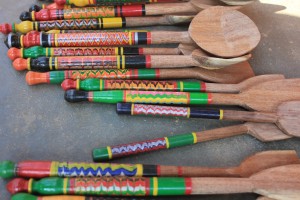 Lacquer work is similarly practiced specially in Kutch and more so in this tiny village of artisans. Lacquer ware is done by colouring hand-carved wooden items with resin obtained from trees. The lac is applied and polished to a smooth glazed finish on a variety of products, from kitchen ladles to little jewellery boxes. It is a humbling experience to watch these talented and renowned artists work while explaining every detail of their art to us with so much passion.
Lacquer work is similarly practiced specially in Kutch and more so in this tiny village of artisans. Lacquer ware is done by colouring hand-carved wooden items with resin obtained from trees. The lac is applied and polished to a smooth glazed finish on a variety of products, from kitchen ladles to little jewellery boxes. It is a humbling experience to watch these talented and renowned artists work while explaining every detail of their art to us with so much passion.
The unusually interesting landscape and topography of Kutch was singled out by British officials in the 19th century as a rich site for finding fossils. Since then, numerous researches and excavations have been conducted here and a variety of fossils have been recovered from the rocks. Around 70 km from Bhuj is the ‘Fossil Park’ founded by Mohansinh M. Sodha; 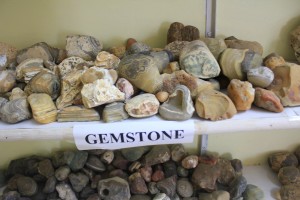 a collector who has such a large collection of original fossils that he has set up this museum of sorts all by himself. Mr. Sodha even has a fossil of a vertebrate sea-cow which was found to be a new species itself and eventually named after him as Dommingia Sodhae. Another spectacular fossil on display is that of a Dinosaur (yes, that’s right, I said Dinosaur!), its teeth and even a Dinosaur egg! You can even meet the amazing Dr. Sodha and get a tour of his museum while he explains every little fossil and the story behind its recovery.
a collector who has such a large collection of original fossils that he has set up this museum of sorts all by himself. Mr. Sodha even has a fossil of a vertebrate sea-cow which was found to be a new species itself and eventually named after him as Dommingia Sodhae. Another spectacular fossil on display is that of a Dinosaur (yes, that’s right, I said Dinosaur!), its teeth and even a Dinosaur egg! You can even meet the amazing Dr. Sodha and get a tour of his museum while he explains every little fossil and the story behind its recovery.
Right next to the Fossil Park is the Than Monastery at the foothill of the inactive volcanic Mountain Dhinodhar. Legend has it that it was here, on top of Mount Dhinodar, that the sage Dhoramnath, founder of a tantric order of yogis known as the Kanphatas (‘Split Ears’), is said to have performed a 12-year penance, standing on the crown of his head. He then established the Than Monastery for fellow sadhus. Today, this monastery (more like a temple) is over 400 years old and you still get to see sadhus living here. For the adventure lover, a short trek up the Dhinodhar Mountain will be well rewarded with a stunning view of the Rann of Kutch and one can also see plenty of wildlife on the way up.
From the Than Monastery, we come to the oasis village of Nani Aral for lunch and a relaxing stay at the Infinity Resort. The most splendid part of Infinity resort is the traditional mud thatched bhunga huts with AC that serve as guest rooms and the serene swimming pool bang in the centre of the resort. A swimming pool in the desert is no less than a dream come true. Relax and enjoy a peaceful night’s stay at the Infinity Resort surrounded by nature and kutchhi culture.
After so much of arts, crafts and culture, it is time to get adventurous and observant and head out to the Chhari Dhand wetland reserves early morning before sunrise. Chhari means salt affected and Dhandh means Shallow wet-lands. This place is a paradise for bird watchers and ornithologists, having around 370 bird species and is particularly rich in raptors, water fly, waders and larks. This place is also famous for the migratory pink flamingos that come here every year in large numbers. Don’t forget to find out why the flamingos are pink in colour only in this part of the world. You will be extremely amazed at Mother Nature’s ways when you find out! Talking about Mother Nature and her strange ways, these Banni grasslands and the adjoining desert of the marshy salt flats of the Rann of Kutch are also known to host an unexplained phenomenon of dancing lights, locally known as Chir Batti or Ghost lights. Intrepid travellers have plenty of reasons to visit this place and maybe even find out why.
The next destination is the revered Mata no Madh where the famous temple of Ashapura Mata, the head deity of Kutch is located. This temple is always busy with local people along with tourists thronging to seek the blessings of the deity. After the darshan, head outside to gorge on the famous Kutchi Dabelis and jalebis renowned for their tantalizing effect on your taste buds. After a hearty breakfast of these delicacies, we move on to explore the rest of Kutch with a smile on our face and a thirst for exploring more of Kutch’s hidden secrets.
The next destination is the erstwhile city of millionaires- Lakhpat. Located at the far north-west corner of Kutch, Lakhpat is known for its historic significance as a major trade city and a port. Today, this place is as good as a ghost town with only the ruins of its former grandeur and might to see. Anyone interested in history and a philosophical contemplation on the changing nature of wealth and power will have plenty to think about in this town. A bustling and prosperous port, 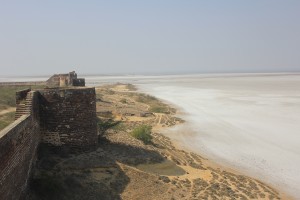 Lakhpat lost its significance when the Sindhu River changed its course away from this town after great earthquakes in 1819. This also made the Great Rann to dry up and form a vast desert land that now stands guard at the border of India and Pakistan. The 7 km long fort walls erected during Lakhpat’s glory days, still stand erect today and offer a magnificent view of the Great Rann of Kutch. A sunset or sunrise at this place is indeed a surreal sight to behold.
Lakhpat lost its significance when the Sindhu River changed its course away from this town after great earthquakes in 1819. This also made the Great Rann to dry up and form a vast desert land that now stands guard at the border of India and Pakistan. The 7 km long fort walls erected during Lakhpat’s glory days, still stand erect today and offer a magnificent view of the Great Rann of Kutch. A sunset or sunrise at this place is indeed a surreal sight to behold.
Lakhpat has a religious significance as well for three of India’s most followed religions-Hinduism, Sikhism and Islam. The Hatkeshwar temple, the Lakhpat Gurudwara Sahib, the Nani Mai Dargah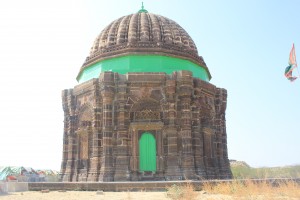 and the Syed Pir Shah Dargah are all located inside the Lakhpat fort walls. All of these religious locations have a remarkable history and an even more breathtaking architecture. Most noteworthy amongst all is the nine-domed mausoleum of Syed Pir Shah which has intricate carvings and excellent stonemasonry.
and the Syed Pir Shah Dargah are all located inside the Lakhpat fort walls. All of these religious locations have a remarkable history and an even more breathtaking architecture. Most noteworthy amongst all is the nine-domed mausoleum of Syed Pir Shah which has intricate carvings and excellent stonemasonry.
Our last stop at Kutch is also the last edge of Indian land on the western coast of India- the Narayan Sarovar. 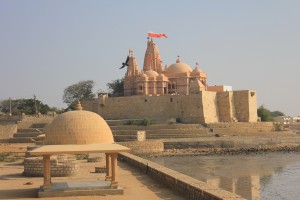 This lake is one of the 5 holy lakes of Hinduism and is associated with a time of drought in the Puranic area, when Narayan (a form of Lord Vishnu) appeared in response to the fervent prayers of sages and touched the land with his toe, creating the vast oasis like lake in the middle of the deserted Kutch.
This lake is one of the 5 holy lakes of Hinduism and is associated with a time of drought in the Puranic area, when Narayan (a form of Lord Vishnu) appeared in response to the fervent prayers of sages and touched the land with his toe, creating the vast oasis like lake in the middle of the deserted Kutch. 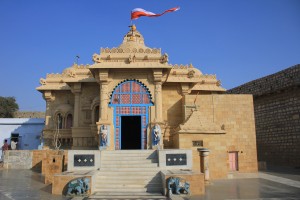 Nearby is another ancient holy temple- the Koteshwar temple. Located right at the edge of the Arabian Sea, this temple is the last outpost of human construction at the westernmost limit of India. Legend has it that if you look closely enough, the lights from Karachi in Pakistan can actually be seen from here at night.
Nearby is another ancient holy temple- the Koteshwar temple. Located right at the edge of the Arabian Sea, this temple is the last outpost of human construction at the westernmost limit of India. Legend has it that if you look closely enough, the lights from Karachi in Pakistan can actually be seen from here at night.
After paying our respects to the lord and the sea, we bid adieu to the beautiful and humbling Rann of Kutch and return to Bhuj for a night’s stay. With a heart full of history and culture and sun-soaked golden memories, we head back home early next morning only to await another journey and another trip full of exhilarating experiences and memories.
